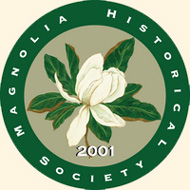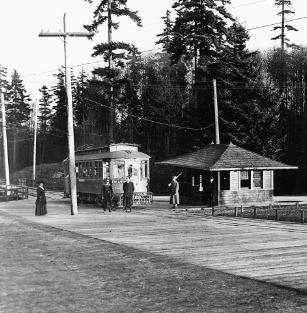A Dairyland of Sorts Back Then
By Monica Wooton,
President of the Magnolia Historical Society
When you ask old time, native Magnolians, a rare breed now in their late 80 and 90’s, about dairies and farms on Magnolia “back in the day”, they have fond memories of a rural utopia. Research has shown that the reality was mainly 3 smallish farms, mostly in Magnolia’s Pleasant Valley, 32nd Avenue West to 34th Avenue West, running North and South.
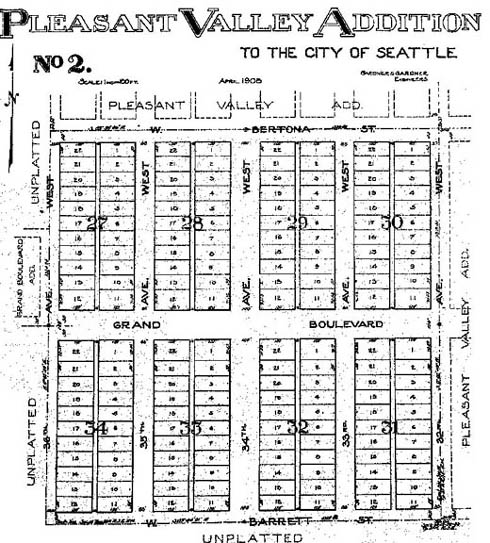
The plat map of Pleasant Valley Addition, 32nd Avenue West (east) to
36th Avenue West (west), Barrett Street (south), and Bertona Street (north). These lots were laid out as single family residences as early as 1888. In the 1900’s three dairy farms were here.
Courtesy of King County Assessor’s Office.
It was a common thing to come to Seattle and stake a claim, become a subsistence farmer and soon realize that exporting natural resources proved a better way to riches: lumber, fish and other commodities were the real money makers.“Dr. Henry A. Smith, [Magnolia’s first Euro pioneer] spent some of his time on his Magnolia claim as a practicing doctor, and a serious hobby gardener. He planted an orchard of specially grafted apple trees—the first of the kind in King County and reaped his first crop three years later. He was an avid experimental gardener who produced many varieties of fruits and vegetables to support the diets of his family of ten. While living at the Tulalip Reservation with his family in tow, and treating the Indians as their doctor, he experimented with the use of tidelands as growing fields. He had some success: onions, rhubarb, apples, and potatoes to name a few.”
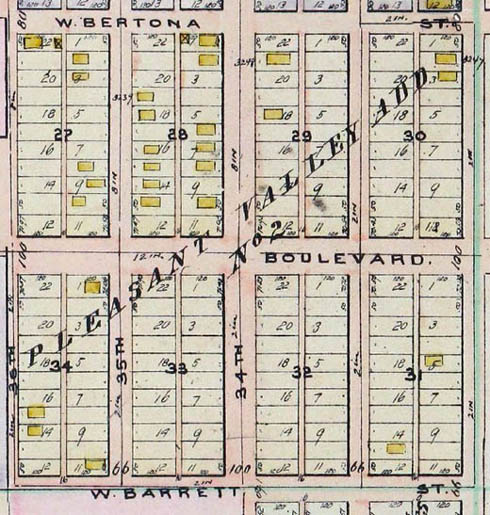
This 1912 Baist map shows Pleasant Valley along with a number of houses (in yellow).
Courtesy of pauldorpat.com
The main secret to growing productive crops on Magnolia lay in the peat bog sometimes referred to as “black gold” and a great feature of Pleasant Valley. But, when it burned, “it burned and burned and was a never ending headache.” “Here and there, this fertile soil produced amazing amounts of flowers and foods (and fires) always having to be tended with hard work by the owner.”
One or two cows (or goats), homegrown vegetables—enough for family tables, a fruit tree or two, a patch of cutting flowers, and sometimes some poultry for eggs were common for a Magnolia family to own. Having more than one cow provided some with enough milk to share or to sell. Magnolia resident, Shirley Allen Young, said that her brother had a small dairy route on 44th Avenue West for the neighborhood.” As did, Monty Holmes and his sister along Commodore Way deliver milk to the Works Progress Administration (WPA) workers doing repairs on that street.
“As to agriculture becoming a vocation on Magnolia, interestingly, some of its property was already being platted out as traditional residential neighborhood lots before it was ever settled or barely even seen. Magnolia was already being envisioned as part of a city planning process similar to that of a suburban neighborhood in the 1990s. Some sections were platted as early as 1888 by out-of-state owners, most probably speculators, from as far as New York.” “East Coasters” found the West Coast a good investment. The Emersons were one such couple. And, a Magnolia street is named for them. A very detailed plat of what appears to be similar to a quite modern suburb was completed for them by a Mr. Barrett, another Magnolia street bears that name. The purpose of the platting was to eventually divide Northwest land into many lots for re-sale with single-family houses…—a replication of the development of eastern city developments.”
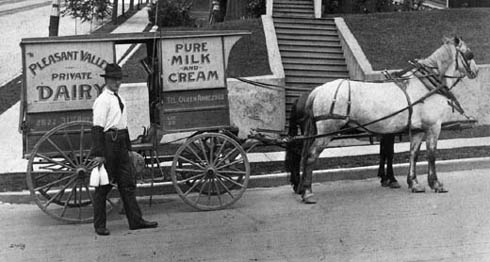
Pleasant Valley Farm was located where Albertson’s is today.
Another successful Magnolia farm serving the
dairy needs of Magnolia and Queen Anne customers.
Courtesy of Neil Smith.
As most early Magnolians literally scratched out a simple living with small crops and chickens, back east there were investors buying land and platting for big city development and residential housing here: “On Magnolia, the landowners who had struggled mightily to farm and prove their claims, seldom profited much as farmers. Seattle’s weather and geography made it very hard. Many were anxious to get rid of their land and move, as Seattle wasn’t what they had expected.”
With the establishment of Fort Lawton, the Locks, Fishermen’s Terminal, the development of the railroad and shipping piers, industrialization was truly born on the Bluff. The population grew and the land was now worth more, but not for farming.
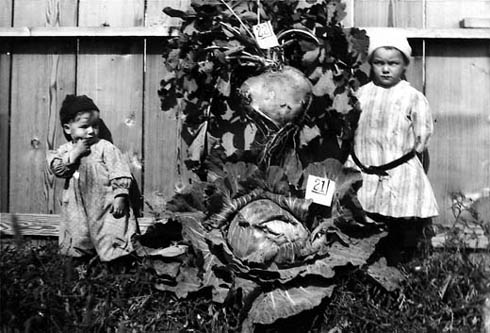
The Auckland truck farm, Magnolia’s very own local produce,was famous for
its huge and beautiful produce. In this picture the young ones of the family
are even a bit fearful of such beets and cabbages!
Courtesy Bett Samuelson. Circa 1925.
There were the farmers/dairymen who were the exception: “Johan (John) August Hanson arrived in the United States in 1905, set about to make money in logging and then purchased his Magnolia Merrymount Farm. Four brothers and sisters from Sweden arrived to work with him shortly afterwards. Pictures…showed a huge, meticulously painted barn, and a well-kept farm. John’s workers and siblings herded the cows on foot. The Pleasant Valley land provided a good water supply from Wolfe Creek and pasture enough for the milk herd and two oxen to survive.” “Knut Knutson took over the land and renamed it West Point Dairy and became a beloved milkman on Magnolia. Even when he was forced off his land and moved to the suburbs to re-establish his dairy, he continued delivering milk to his Magnolia customers until the 1960’s.” Between 1900 and 1936 there were 13 farms listed in the Seattle Polk Directory-most very small in scale and not long lasting.
Now…
The most fertile land once farmed on Magnolia is now where Our Lady of Fatima Parrish sits and where the ball-fields are. But, a little bit of the “olden days” can be experienced June 1 through September 28th when The Magnolia Farmer’s Market returns to The Village for its 10th anniversary with over 15 farms represented. Fresh cut flowers, local organic produce, artisan baked goods and cheeses will be for sale again this year. The first Saturday of the Market, July 13tht, The Magnolia Historical Society will be selling copies of the two award winning Magnolia History Books. It will be a “donate what you can” sale (regularly $50 a set) proceeds to help The Magnolia Community Club and The Historical Society do their non-profit work in the community. Look for the roving red wagon and buy your piece of Magnolia history. And, check out the chapter: Rural Magnolia: A Pastoral Place.

